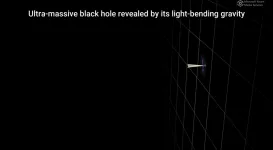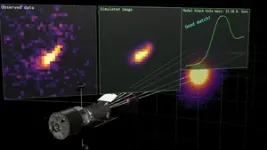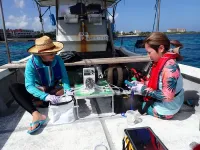(Press-News.org) A team of astronomers has discovered one of the biggest black holes ever found, taking advantage of a phenomenon called gravitational lensing.
The team, led by Durham University, UK, used gravitational lensing - where a foreground galaxy bends the light from a more distant object and magnifies it – and supercomputer simulations on the DiRAC HPC facility, which enabled the team to closely examine how light is bent by a black hole inside a galaxy hundreds of millions of light years from Earth.
They found an ultramassive black hole, an object over 30 billion times the mass of our Sun, in the foreground galaxy – a scale rarely seen by astronomers.
This is the first black hole found using the technique, whereby the team simulates light travelling through the Universe hundreds of thousands of times. Each simulation includes a different mass black hole, changing light’s journey to Earth.
When the researchers included an ultramassive black hole in one of their simulations the path taken by the light from the faraway galaxy to reach Earth matched the path seen in real images captured by the Hubble Space Telescope.
The findings are published today [Wednesday 29th March 2023] in the journal Monthly Notices of the Royal Astronomical Society.
Lead author Dr James Nightingale, Department of Physics, Durham University, said: “This particular black hole, which is roughly 30 billion times the mass of our Sun, is one of the biggest ever detected and on the upper limit of how large we believe black holes can theoretically become, so it is an extremely exciting discovery.”
A gravitational lens occurs when the gravitational field of a foreground galaxy appears to bend the light of a background galaxy, meaning that we observe it more than once.
Like a real lens, this also magnifies the background galaxy, allowing scientists to study it in enhanced detail.
Dr Nightingale said: “Most of the biggest black holes that we know about are in an active state, where matter pulled in close to the black hole heats up and releases energy in the form of light, X-rays, and other radiation.
“However, gravitational lensing makes it possible to study inactive black holes, something not currently possible in distant galaxies. This approach could let us detect many more black holes beyond our local universe and reveal how these exotic objects evolved further back in cosmic time.”
The study, which also includes Germany’s Max Planck Institute, opens up the tantalising possibility that astronomers can discover far more inactive and ultramassive black holes than previously thought, and investigate how they grew so large.
The story of this particular discovery started back in 2004 when fellow Durham University astronomer, Professor Alastair Edge, noticed a giant arc of a gravitational lens when reviewing images of a galaxy survey.
Fast forward 19 years and with the help of some extremely high-resolution images from NASA’s Hubble telescope and the DiRAC COSMA8 supercomputer facilities at Durham University, Dr Nightingale and his team were able to revisit this and explore it further.
The team hopes that this is the first step in enabling a deeper exploration of the mysteries of black holes, and that future large-scale telescopes will help astronomers study even more distant black holes to learn more about their size and scale.
The research was supported by the UK Space Agency, the Royal Society, the Science and Technology Facilities Council (STFC), part of UK Research and Innovation (UKRI), and the European Research Council.
This work used both the DiRAC Data Intensive Service (CSD3) and the DiRAC Memory Intensive Service (COSMA8), hosted by University of Cambridge and Durham University on behalf of the DiRAC High-Performance Computing facility.
ENDS
END
Light-bending gravity reveals one of the biggest black holes ever found
2023-03-29
ELSE PRESS RELEASES FROM THIS DATE:
Detecting coral biodiversity in seawater samples
2023-03-29
Researchers from the Okinawa Institute of Science and Technology (OIST) have developed a method to measure coral biodiversity through extracting the environmental DNA (or eDNA) from a liter of surface seawater collected from above a reef. The method has been confirmed to work through observations made by scientific divers in the same areas of ocean. The research, conducted in collaboration with the Okinawa Prefecture Environmental Science Center and University of Tokyo, was published in the Proceedings of the Royal Society B: Biological Sciences. This has paved the way for large-scale comprehensive surveys of reef-building coral to take place and removes the reliance of ...
Research autopsies reveal how incurable skin cancer resists treatment
2023-03-29
Scientists have found out how some skin cancers stop responding to treatment at the end of life.
An in-depth analysis of 14 patients who died from incurable melanoma has revealed that changes to the order, structure and number of copies of tumour DNA could cause some skin cancers to resist treatment. These changes also explain how melanoma can spread to other parts of the body.
The research, published today (29th March) in the journal Cancer Discovery, was led by scientists and clinicians at the Francis Crick Institute, UCL and The Royal Marsden. It is part of the Cancer ...
COVID vaccine induces robust T cell responses in blood cancer patients
2023-03-29
Researchers found that, despite being heavily immunocompromised, haematology patients generate strong cellular immune responses against SARS-CoV-2 after vaccination, on par with that of healthy individuals.
Published today in Cell Reports Medicine, the research team, led by University of Melbourne Professor Katherine Kedzierska, a Laboratory Head at the Peter Doherty Institute for Infection and Immunity (Doherty Institute), undertook the most comprehensive analysis of adaptive SARS-CoV-2 immunity to ...
Revolutionary battery technology to boost EV range 10-fold or more
2023-03-29
The electric vehicle market has been experiencing explosive growth, with global sales surpassing $1 trillion (approx. KRW 1,283 trillion) in 2022 and domestic sales exceeding 108,000 units. Inevitably, demand is growing for high-capacity batteries that can extend EV driving range. Recently, a joint team of researchers from POSTECH and Sogang University developed a functional polymeric binder for stable, high-capacity anode material that could increase the current EV range at least 10-fold.
A research team led by POSTECH professors Soojin Park (Department of Chemistry) and Youn Soo Kim (Department ...
Cooking up plasmas with microwaves
2023-03-29
Kyoto, Japan -- Lead author Yurii Victorovich Kovtun, despite being forced to evacuate the Kharkiv Institute of Physics and Technology amid the current Russia-Ukraine war, has continued to work with Kyoto University to create stable plasmas using microwaves.
Getting plasma just right is one of the hurdles to harnessing the massive amounts of energy promised by nuclear fusion.
Plasmas -- soups of ions and electrons -- must be held at the right density, temperature, and duration for atomic nuclei to fuse together to achieve the desired release of energy.
One recipe involves the use of large, donut-shaped devices with powerful magnets ...
12th World Conference of Science Journalists opens under open skies
2023-03-29
The opening day of the World Conference of Science Journalists (WCSJ) 2023 in Medellín, Colombia saw hundreds of journalists from 62 countries come together in the stunning setting of the city’s Jardin Botanico.
Over 500 attendees will gather over three days to discuss science journalism, to challenge ideas and to reinforce their professional networks and friendships.
The day began with a keynote on biodiversity delivered by Brigitte Baptiste, a Colombian biologist and expert in biodiversity issues. And it closed with an opening ceremony and vibrant social event for attendees.
Both took place under open skies in the ...
Revealing the nature of fractures caused by hydrogen in high-strength steel
2023-03-29
One of the many ways to reduce the energy required for transportation is to make vehicles lighter. High-strength (HS) steels are perfect candidate materials for this purpose, as their higher weight-to-strength ratio allows for the use of less metal to achieve a similar structural integrity. Many automobile companies believe HS steels will be an essential component of various types of cars in the future. However, for this to become a reality, there is a glaring problem that needs to be solved.
When HS steel is exposed to rainwater (H2O) or hydrogen, a phenomenon known as hydrogen embrittlement occurs. Hydrogen atoms diffuse into the lattice ...
Implementing green corridors throughout Barcelona could reduce annual antidepressant use and visits to mental health specialists by 13%
2023-03-29
A health impact assessment led by the Barcelona Institute for Global Health (ISGlobal), a centre supported by the ”la Caixa” Foundation, has concluded that implementing green corridors throughout the city of Barcelona would result in a “considerable reduction” in mental disorder cases in adult residents as well as in direct and indirect costs associated to said cases. The study was published in the journal Environment International.
It is estimated that mental health disorders ...
AI shows the need for healthier diets in long-term care homes
2023-03-29
A detailed analysis of consumed food showed there is a need to improve diets in long-term care (LTC) homes to make them healthier for residents.
The analysis found that eating more whole grains, plant-based proteins, and plain fruits and vegetables would help residents meet government guidelines and reduce their risk of inflammation.
Researchers at the University of Waterloo developed new artificial intelligence (AI) technology to examine data on food and fluids consumed by more than 600 residents over three days at 32 LTC homes.
Results were compared to recommendations in the 2019 Canada’s Food Guide on healthy eating and expert ...
Eye-tracking during building inspections provides insight on how experts think
2023-03-28
UNIVERSITY PARK, Pa. — After a building failure due to natural disasters or poor structural design, safety inspectors must enter a structure to assess the damage before occupants can return. Researchers in the Penn State Department of Architectural Engineering studied how building inspectors make their safety assessments, by analyzing their gaze patterns with eye-tracking software. Eventually, the eye-tracking data could be used to code autonomous robots, like drones, to conduct building assessments in place of humans.
The researchers' results were published in Scientific Reports.
“We ...







